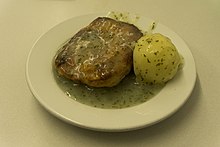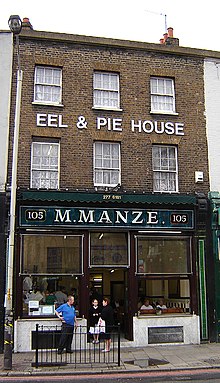Eel pie and mash was London’s original fast-food but the iconic eateries are rapidly disappearing from gentrifying inner city postcodes as the owners retire and sell up.
https://on.ft.com/2I1cB33
https://on.ft.com/2I1cB33
mash翻譯:將(食物)搗成泥狀,把(食物)搗爛,搗碎, 嚴重損毀, 馬鈴薯泥(同mashedpotatoes)。
Pie and mash
Pie and mash is a traditional working-class food, originating in the East End of London. Pie, mash and eel shops have been in London since the 19th century, and are still common in East and South London and in many parts of Kent and Essex. The shops may serve stewed or jellied eels.
Contents
History[edit]
During the Victorian era, industrial air pollution tended to be worse in the east and south east of London because of the prevailing westerly wind, with the result that the East End was settled more by the working classes, while the western part of the city was home to higher social classes.[1] The working class were poor and favoured foodstuffs that were cheap, in plentiful supply and easy to prepare.
The savoury pie had long been a traditional food, and its small handsized form also made it a transportable meal, protected from dirt by its cold pastry crust, and filled with cheap minced meat, usually mutton.[2] Adding cheap mashed potatoes, together with a sauce made with fish stock and parsley, made it a plate-based sit-down meal.
Jellied eels are often associated with pie and mash, as European eels cooked in gelatine also became a common worker's meal since eels were one of the few forms of fish that could survive in the heavily polluted River Thames and London's other rivers at that time. Supply was plentiful through the late 19th century, particularly from the Dutch fishing boats landing catches at Billingsgate Fish Market.
Since 2010, as revealed in a joint study by the Zoological Society of London and the Environment Agency, the number of eels captured in research traps in the River Thames fell from 1,500 in 2005 to 50 in 2010,[3] meaning most eels used in pie and mash shops are now from the Netherlands and Northern Ireland.







沒有留言:
張貼留言